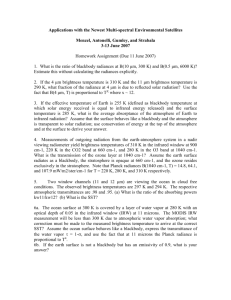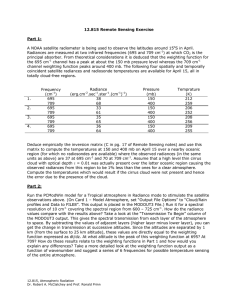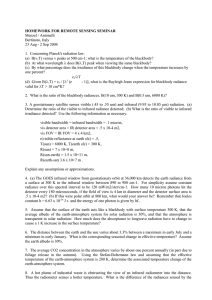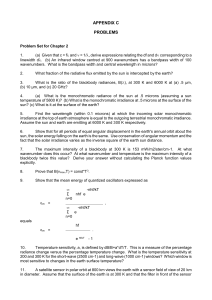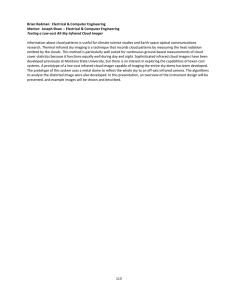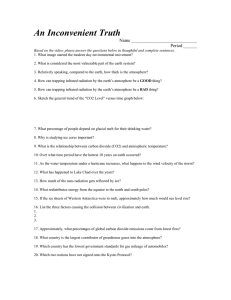APPENDIX C PROBLEMS Problem Set for Chapter 2
advertisement
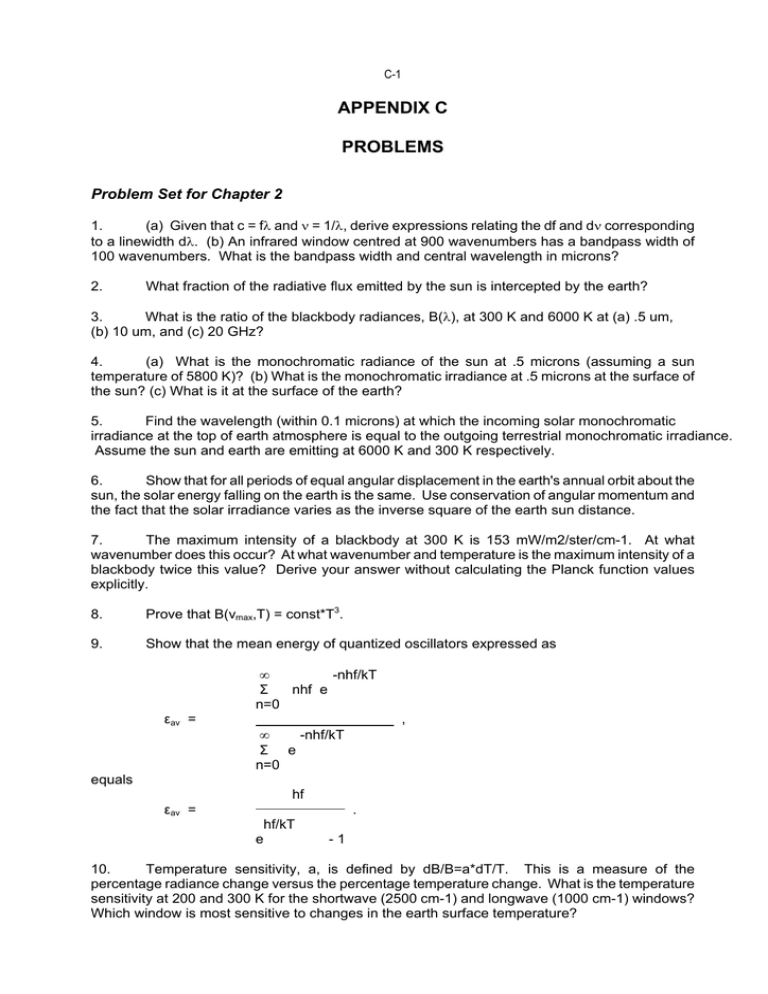
C-1 APPENDIX C PROBLEMS Problem Set for Chapter 2 1. (a) Given that c = fλ and ν = 1/λ, derive expressions relating the df and dν corresponding to a linewidth dλ. (b) An infrared window centred at 900 wavenumbers has a bandpass width of 100 wavenumbers. What is the bandpass width and central wavelength in microns? 2. What fraction of the radiative flux emitted by the sun is intercepted by the earth? 3. What is the ratio of the blackbody radiances, B(λ), at 300 K and 6000 K at (a) .5 um, (b) 10 um, and (c) 20 GHz? 4. (a) What is the monochromatic radiance of the sun at .5 microns (assuming a sun temperature of 5800 K)? (b) What is the monochromatic irradiance at .5 microns at the surface of the sun? (c) What is it at the surface of the earth? 5. Find the wavelength (within 0.1 microns) at which the incoming solar monochromatic irradiance at the top of earth atmosphere is equal to the outgoing terrestrial monochromatic irradiance. Assume the sun and earth are emitting at 6000 K and 300 K respectively. 6. Show that for all periods of equal angular displacement in the earth's annual orbit about the sun, the solar energy falling on the earth is the same. Use conservation of angular momentum and the fact that the solar irradiance varies as the inverse square of the earth sun distance. 7. The maximum intensity of a blackbody at 300 K is 153 mW/m2/ster/cm-1. At what wavenumber does this occur? At what wavenumber and temperature is the maximum intensity of a blackbody twice this value? Derive your answer without calculating the Planck function values explicitly. 8. Prove that B(vmax,T) = const*T3. 9. Show that the mean energy of quantized oscillators expressed as ∞ -nhf/kT Σ nhf e n=0 εav = , ∞ -nhf/kT Σ e n=0 equals hf εav = . hf/kT e -1 10. Temperature sensitivity, a, is defined by dB/B=a*dT/T. This is a measure of the percentage radiance change versus the percentage temperature change. What is the temperature sensitivity at 200 and 300 K for the shortwave (2500 cm-1) and longwave (1000 cm-1) windows? Which window is most sensitive to changes in the earth surface temperature? C-2 11. A satellite sensor in polar orbit at 800 km views the earth with a sensor field of view of 20 km in diameter. Assume that the surface of the earth is at 300 K and that the filter in front of the sensor transmits all radiation in the spectral region 820 and 970 wavenumbers. Determine the spectral irradiance detected. How does this change if the field of view is 1 km in diameter and the filter only transmits radiation between 880 to 930 wavenumbers? 12. The Meteosat infrared window covers 790 to 940 cm-1. The GOES infrared window covers to 890 to 980 cm-1. What is the difference in the irradiance detected by the two sensors when viewing a scene at 300 K? What is the difference in brightness temperature detected? Assume that the atmosphere is transparent at these wavelengths. 13. The new GMS-5 water vapour band covers the spectral range of 1400 to 1490 cm-1. Adjust the Planck function to account for the spectral width by replacing T with a+bT, where you must determine a and b by least squares fit over the terrestrial temperature range 180 to 300 K. Badj(νc,T) = B(νc, a+bT) = ∫ B(ν,T) S(ν) dν / ∫ S(ν) dν Assume that the spectral response, S(ν),is one inside and zero outside this range and that the centre wavenumber, νc, is 1445 cm-1. What is the largest error in brightness temperature in the terrestrial range if you assume a=0 and b=1? 14. A geostationary satellite senses visible (.45 to .55 um) and infrared (9.95 to 10.05 µm) radiation. (a) Determine the ratio of the visible to infrared radiance detected; (b) What is the ratio of visible to infrared energy detected? Use the following information as necessary. visible bandwidth = infrared bandwidth = .1 micron, vis detector area = IR detector area = .5 x 10-4 m2, vis FOV = IR FOV = 4 x 4 km2, r(visible reflectance at earth sfc) = .5, T(sun) = 6000 K, T(earth sfc) = 300 K, R(sun) = 7 x 10+8 m, R(sun-earth) = 1.5 x 10+11 m, R(earth-sat) 3.6 x 10+7 m . 15. The Planck function constants have been adjusted. c1 is now 1.191044 x 10-5 mW/(m2*sr*cm-4), down from 1.191066. c2 is now 1.43877 cm*K, down from 1.43883. What is the resulting percentage change in the radiance from a 300 K target at 900 cm-1. Problem Set for Chapter 3 1. (a) The solar irradiance reaching Jupiter is roughly 50 W/m**2. Assuming the albedo, A, of Jupiter is 60%, calculate the effective temperature, Te, by equating the absorbed solar radiation with the emitted thermal radiation; (b) If there is an incremental change in albedo, dA/A, what is the corresponding change in effective temperature, dTe/Te? 2. If the effective temperature of Mars is 220 K and the surface temperature is 240 K, what is the average absorptance of the atmosphere of Mars to longwave radiation? Assume that the surface behaves like a blackbody and the atmosphere is transparent to solar radiation; use conservation of energy at the top of the atmosphere and at the surface to derive your answer. 3. Venus is 25% closer to the sun than the earth (Rvs = .75Res) and its effective temperature is 230 K. What is the albedo of Venus with respect to the earth albedo? C-3 4. The distance of a cylindrical spinning geostationary satellite is about six times the earth radius. The satellite has its spin axis aligned with the earth spin axis. The radius of the cylinder is equal to its height. Calculate the equilibrium temperature of the satellite in the earth-satellite system (ignoring the sun), assuming an effective equilibrium temperature for the earth of 255 K and assuming the satellite is a blackbody. 5. The distance between the earth and the sun varies about 3.3% between a maximum in early July and a minimum in early January. What is the corresponding seasonal change in effective temperature? Assume the earth albedo is 30%. 6. Assume that the surface of the earth acts like a blackbody with surface temperature 300 K, that the average albedo of the earth-atmosphere system for solar radiation is 30%, and that the atmosphere is transparent to solar radiation: (a) What is the average absorptance to longwave radiation? (b) How much does the absorptance to longwave radiation have to change to cause a 1 K increase in the surface temperature? (c) How much does the albedo have to change to offset the change in atmospheric longwave absorptance in order to keep the surface temperature constant? Solve (b) by relating the change in absorptance, da, to the change in surface temperature, dTs, and then solve (c) by relating da to the change in albedo, dA. 7. (a) Derive an expression for the irradiance emitted by the topmost layer of a multi-layered atmosphere, transparent in the visible, in terms of the absorptivity of the layer in the infrared, a, and the total irradiance of planetary radiation emitted to space, E. (b) Show that for an infinitesimally thin topmost layer, the radiative equilibrium temperature of the top of the atmosphere approaches 84% of the effective radiative equilibrium temperature of the whole planet. Hint: let absorptivity, a, for the thin top-most layer approach zero. 8. Consider the earth to have an albedo of 30% and an atmosphere consisting of two layers. Each layer has an absorptance of 0.1 for incoming solar radiation; the upper (lower) layer has an absorptance of 0.4 (0.6) for outgoing longwave radiation. Assume that the surface of the earth behaves like a blackbody. Calculate the radiative equilibrium temperatures of the surface of the earth and the two atmospheric layers. 9. (a) The GOES infrared window from geostationary orbit at 36,000 km detects the earth radiance from a surface at 300 K in the infrared window between 890 to 980 cm-1. For simplicity assume constant radiance over this spectral interval to be 120 mW/m2/ster/cm-1. How many 10 micron photons hit the detector every 180 microseconds, if the field of view is 4 km in diameter and the detector surface area is .5 x 10-4 m2? (b) If this were polar orbit at 800 km, what would your answer be? 10. Assume that the angular momentum of the earth due to its motion around the sun is quantized according to Bohr's relation mvr = nh/2π. What is the quantum number n? Can this quantum number be detected? 11. The Lyman emission lines are associated with transitions of excited states to the ground state of the hydrogen atom. What are the wavenumbers of the first three lines of the Lyman series? From these data infer the wavenumber of the first line of the Balmer series (transitions from the second excited state to the first excited state). Can the hydrogen atom emit (or absorb) in the infrared? Explain. 12. (a) The rotational spectrum of CO2 shows a series of evenly spaced lines 1.5 cm-1 apart. What does this imply about the moment of inertia of the CO2 molecule? (b) The vibrational absorption line for CO2 occurs at 2325 cm-1 (4.3 microns). What does this imply about the “spring constant” of CO2 vibrations given that the mass of a proton is 1.67x10-27 kg? C-4 13. (a) Determine the normal modes of vibration for a linear O3 molecule; (b) Recalling that the mass of the proton is given by mp = 1.67x10-27 Kg, that the spring constant for the O3 is roughly k ~ 3.35x102 J/m2 (from the second derivative of the potential curves), and that mass of O is 16mp, find the absorption wavelength of O3 for the three modes. Appendix A presents a similar calculation for the CO2 molecule. 14. A certain gas has an absorption coefficient of 0.02 m2/kg for all wavelengths. What fraction of a beam of incident radiation is absorbed in passing vertically through a layer containing 1.5 kg/m2 of the gas. How much gas would the layer have to contain in order to absorb one-fifth of the incident radiation? 15. (a) Consider an atmospheric constituent which has a mixing ratio of unity for all heights and whose absorption coefficient at wavelength w is given by kw(p) = kw(0)(p/p0) ½ where p0 is sea level pressure. Derive an expression for sunlight radiance which arrives at sea level, Iw(0), after traversing the atmosphere at zenith angle z, given the radiance incident at the top of the atmosphere, Iw(∞). (b) If the absorption by the total atmosphere is 75% for normal incidence, what is the value of the absorption coefficient at sea level, kw(0)? Use p0 as 1.013 x 10**5 J/m3. 16. The average CO2 concentration in the atmosphere varies by about one percent annually (in part due to foliage release in the autumn). How do the radiance and the brightness temperature at 676 cm-1 in the middle of the CO2 absorption band change in response? Explain any approximations you make in deriving your answer. 17. A two-channel (19 and 22 Ghz) microwave radiometer on the ground is looking straight up. The brightness temperature measured is given by where Tν = (1 - τν) Tlow atm τν = exp(-kνu). The upper atmosphere does not emit significantly at 19 and 22 Ghz. The moisture is confined to the lower atmosphere which is assumed to be isothermal at 280 K. What is the brightness temperature difference T19 - T22 as a function of water vapor path length? Use k19 = 3.75 x 10-3 kg-1m2 and k22 = 9.12 x 10-3 kg-1m2 and let u increase from 5 to 40 kg m-2 in 5 kg m-2 increments. 18. Derive an expression for dτ(p,ps)/dp in terms of τ(ps,0), τ(p,0), and dτ(p,0)/dp where τ(pa,pb) is the probability of transmission from pressure level pa to pb for a given wavelength. ps denotes the surface pressure and 0 indicates the pressure at the top of the atmosphere. 19. On a clear day, measurements of the direct solar irradiance E at the surface of the earth in the 1.5 to 1.6 micron wavelength interval give the following values: Zenith angle (degrees) E (W/m2) 40 1.40 10**-3 50 1.26 60 1.05 70 0.76 C-5 Find the solar irradiance at the top of the atmosphere and the transmittance for normal incidence in this wavelength interval. 20. Consider a slab of material that has a transmittance τ and has a reflectance r at each surface. Derive a expression for the transmitted radiance, I(s), in terms of the incident radiance, I(0), and r and τ. r I(0) → r → τ → ← τ ← → I(s) 21. The big bang theory predicts that the average radiance from deep space should have a brightness temperature of 2.7 K. This has been observed with microwave remote sensing. In addition the sky near the southern end of the constellation Leo has been noticed to be warmer by about 0.003 K when viewed at 6 cm-1. Assuming this is consistent with a Doppler shift, what is the velocity of south Leo with respect to our part of the universe (e.g. the Milky Way)? Problem Set for Chapter 4 1. Consider the black and white spheres used by Suomi to measure visible and infrared irradiance in the earth atmosphere. The absorptance of the white ball is .3 and .7 for short and longwave radiation respectively; for the black ball it is .9 for all wavelengths. The temperature of the white ball is 255 K; for the black ball it is 300 K: (a) What is the outgoing infrared irradiance? (b) If the temperature of the black ball decreases by one degree, is the change in inferred outgoing infrared irradiance greater or smaller than if the temperature of the white ball increases by one degree? 2. Calculate the daily insolation on the top of the atmosphere at (a) the south pole in the winter solstice, and (b) the equator in the vernal equinox. Use the mean earth-sun distance and a solar constant of 1380 W/m2 in your calculations. 3. If one-third of the incident solar energy were absorbed by the atmosphere, what would be the average rate of temperature increase per day of the atmosphere (assuming no loss)? Use for the atmosphere, specific heat at constant pressure Cp = 1005 J kg-1 K-1, density ρ = 1.3 kg m-2, and atmospheric depth (scale height) H = 7 km. 4. Prove that for an atmosphere in infrared radiative equilibrium, the total infrared optical depth is given by the expression σ*tot = (Tsfc4/Ttop4) - 2 . Start with the equations for irradiance going up and down through the atmosphere. dE↑/dσ* = E↑ - πB -dE↓/dσ* = E↓ - πB and realize that the net irradiance E↑ - E↓ is constant at all levels. πB is given by Stefans Law. 5. Assuming the atmosphere is an absorber with uniform absorption coefficient and uniformly mixed with height, what is the (a) net irradiance (b) the temperature discontinuity at the surface, and (c) the total atmospheric infrared optical depth under radiative equilibrium conditions when the top C-6 of the atmosphere is at 201 K and the surface ground temperature is at 280 K? 6. The figure in Chapter 4 depicting annual mean global energy balance for the earthatmosphere system shows 30 units of radiation (one unit equals 3.43 W/m2) going to sensible and latent heat flux in the atmosphere. If these processes were removed from the picture, how much hotter would the earth surface have to be in order to maintain thermal equilibrium for the earthatmosphere system? Problem Set for Chapter 5 1. Consider a three channel radiometer with spectral bands centred at 676.7, 708.7, and 746.7 cm-1 that is sensing radiation from an atmosphere with the following temperature and transmittance profiles. Pressure Temperature Transmittance 676.7 708.7 746.7 10mb 233 K .86 .96 .98 150 222 .05 .65 .87 600 251 .00 .09 .61 1000 280 .00 .00 .21 (a) Use a simple quadrature formula to evaluate the expected upwelling radiance Rv for each sounding channel from the radiative transfer equation. o Rν = Bν(Ts)τν(ps) + ∫ Bν(Tp) dτν ps = Bν(T1000)τν(1000) + 1/2 (Bν(600)+Bν(1000)) (τν(600)-τν(1000)) + 1/2 (Bν(150)+Bν(600)) (τν(150)-τν(600)) + 1/2 (Bν(10)+Bν(150)) (τν(10)-τν(150)) (b) Let pv denote the pressure level at which the maximum of the weighting function for a given spectral band is located (pv = 50, 400, 900 mb for 676.7, 708.7, and 746.7 cm-1, respectively). Assume Ts = 280 K is known. Use a guess T(p) of T50 = 200, T400 = 250, T900 = 270 K. Calculate the guessed upwelling radiance Iv for each sounding channel from Iν = 600 Bν(Ts) τν(ps) + Bν(900) ∫ dτν 1000 150 10 + Bν(400) ∫ dτν + Bν(50) ∫ dτν 600 150 = Bν(1000) τν(1000) + Bν(900) (τν(600) - τν(1000)) + Bν(400) (τν(150) - τν(600)) C-7 + Bν(50) (τν(10) - τν(150)) (c) Using the relaxation equation developed by Chahine, do two iterations to recover the best estimate of the temperature profile (T50, T400, and T900). This requires iterating as follows: Rν ____ = Iνold Bν(Tnew(pν)) ____________ Bν(Told(pν)) (d) What approximations did you make in arriving at your answer? Estimate the errors in your resulting temperature profile. (e) If you prefer, do two iterations using the Smith Iteration Method for (c) instead of the Chahine Relaxation Method. 2. When the atmosphere is guessed to be isothermal, show that the iteration solution by the Chahine Relaxation Method is independent of the guessed temperature. 3. A microwave radiometer in the window region is viewing a cloud at 400 mb (εcld = 0.5, Tcld = 240 K) obscuring the surface (εsfc = 1.0, Tsfc = 300 K). Assuming the lapse rate a = 10 K per 100 mb and the transmittance τ = 1.0-.0001*p where p is in mb, what is the observed brightness temperature? 4. (a) What brightness temperature will a nadir viewing microwave radiometer operating at -1 1.35 cm (absorption coefficient equal to .0100 m2/kg) measure over land (assume surface emissivity equal to 1) for the atmospheric moisture and temperature profile given below? pressure (mb) Temperature (K) mixing ratio (g/kg) 0 0 0 200 200 .02 600 240 0.20 800 280 2.00 1000 300 8.00 Start by calculating the transmittance for each layer using the relation ∆τ = k g-1 q ∆p and realizing that 100 N/m2 = 1 mb. (b) What is the new brightness temperature, if the surface emissivity changes to .9? Problem Set for Chapter 6 1. A hot plume of industrial waste is obstructing the view of an infrared radiometer into the distance. Thus the radiometer senses a hotter temperature. What is the difference of the radiances sensed by the radiometer when viewing a clear FOV and then a plume contaminated FOV? Use the indicated transmittances and blackbody radiances for background, plume, and C-8 foreground to calculate your answer. Temperature, T (degrees K) Planck Rad, B (mW/m2/ster/cm-1) Transmittance, τ (dimensionless) Background plume foreground Tb=300 Tp=340 Tf=300 Bb=115 Bp=195 Bf=115 τb=.9 τp=.3 τf=.9 2. Consider the simplified model of the shortwave energy balance shown below. The model atmosphere consists of an upper layer with transmittance τ1, a partial cloud layer with the fractional area fc covered by clouds with reflectance rc in either direction, and a lower layer with transmittance τ2. The earth surface has an average reflectance rs. Assume that no absorption takes place within the cloud layer and that no scattering takes place within layers 1 and 2. Allow for multiple reflections. top τ1 rc ---------f τ2 ---------- cloud -------------------- rs sfc (a) Derive an expression for the planetary albedo; (b). Calculate the albedo for fc=0.75, rc=0.5, τ1=0.95, τ2=0.90, and rs=0.15; (c) Use the model to estimate the albedo of a cloud free earth; (d) Use the model to estimate the albedo of a completely cloud covered earth. 3. An infrared radiometer with 4 channels is viewing a clear field of view (fov). The following table presents wavelength and noise equivalent radiance. The surface temperature is 300 K. A little bit of high opaque cloud at 230 K moves in. How much cloud can be present in the fov (what percentage) and still not be detected (be within instrument noise) for each channel? Use B x proportional to T where x=c2*ν/T. Channel Wavenumber (cm-1) NEDR (mW/m2/ster/cm-1) 1 2500 0.004 2 1450 0.1 3 900 0.1 4 700 0.8 4. Calculate the radiances at 8, 11, 12 µm for a scene of clear sky at 300 K and a cloud at 230 K with varying cloud amount. Let the cloud fraction vary from N = 0.0, 0.2, 0.4, 0.6, 0.8, and 1.0. Convert the radiances to brightness temperatures. Plot brightness temperature differences 8 - 11 versus 11 - 12 for the six different cloud fractions. Problem Set for Chapter 7 C-9 1. A histogram of frequency versus infrared window brightness temperature is tabulated over a portion of the Indian Ocean. A least squares fit of the normal distribution probability function at the warm end of the histogram yields ln f = -10272.7 + 70.2T - 0.12T2. What is the SST? 2. Assume that a two channel radiometer is viewing broken clouds. One channel is the longwave IR window channel and it measures 50 and 60 radiance units from adjacent fields of view (fovs). The other channel is a CO2 sensitive channel and it observes 65 and 80 radiance units respectively from the same two fovs. A nearby cloud free fov yields a window channel measurement of 100 radiance units: (a) What is the cloud free value of the CO2 channel observation? (b) If one fov is completely filled with clouds, what is the percentage cloud cover of the other fov? 3. There is a low layer of mist at 280 K obscuring the ocean at 300 K. A microwave radiometer is measuring sea surface temperature with 18 GHz observations. Assume that the emissivity of sea water is .5 and the optical thickness of the mist is .03. What error does the mist introduce to the brightness temperature determination of SST? Include the effects of surface reflection. 4. A split window channel radiometer measures 96.00 and 102.29 mW/m2/ster/cm-1 for the 11 (909) and 12 (833) micron (cm-1) channels respectively. The estimated atmospheric transmittance is .85 and .75 respectively for the two channels; the estimated sea surface emittance is .97 for both channels. What is the estimated sea surface temperature (SST)? Hint: Use B(833,T) = 9.55+1.03*B(909,T) and set up two equations (from R(833,Tb) and R(909,Tb) measurements) with two unknowns (B(909,Ts) and B(909,Ta)), where Ts is the SST and Ta is the mean atmospheric temperature) Problem Set for Chapter 8 1. A radiometer observes clear column brightness temperatures of 291 and 282 degrees Kelvin at 11.0 and 12.7 microns respectively: (a) Assuming the water vapour absorption coefficients are .2 and .5 cm**2/g for the two channels, what is the surface temperature? (b) If the mean atmospheric temperature is 257 degrees Kelvin for the 12.7 micron channel, what is the estimated total precipitable water vapour? (c) If the variance in the observed brightness temperatures for 5x5 FOVs for the 12.7 micron channel is one half that for the 11.0 micron channel, what is the estimated total precipitable water vapour from the split window variance ratio? 2. Consider two cloud layers completing filling the satellite sensor field of view. Show that Iobs - Iclr = Pc1 Pc2 ε1 ∫ τ dB + ε2 ∫ τ dB Ps Ps Pc1 ε1 ε2 ∫ τ dB Ps where εi and Pci are the emissivity and cloud pressure of the lower cloud (I=1) and the upper cloud (I=2). 3. The radiances for a cloudy field of view (fov) are measured to be 46.6, 60.3, and 52.5 mW/m2/ster/cm-1 in the 14.0, 13.3, and 11.2 micron channels respectively. The clear radiances inferred from nearby clear fovs are 55.3, 85.0, 84.0 mW/m2/ster/cm-1 respectively: (a) Using the window channel technique, estimate the cloud top pressure in the cloudy fov; (b) C-10 Using the CO2 absorption technique, estimate the cloud top pressure in the cloudy fov (see the following table for some of the necessary data). Explain the difference with the infrared window estimation; (c) Estimate the effective cloud amount using the cloud top pressure from (b); (d) If the noise in each measurement is .5 mW/m2/ster/cm-1, what is the range of possible cloud top pressure estimates using the CO2 technique? P T τ14.0 τ13.3 τ11.2 B14.0 B13.3 B11.2 1000 279 .00 .30 .91 111.9 107.3 85.3 850 275 .06 .46 .96 106.0 101.3 79.8 700 266 .12 .61 .99 93.1 88.5 68.0 600 260 .18 .69 .99 85.0 80.4 60.7 500 252 .27 .76 .99 74.8 70.4 51.8 400 244 .38 .82 .99 65.3 61.0 43.8 300 230 .50 .86 .99 50.4 46.5 31.7 200 218 .61 .90 .99 39.3 35.8 23.3 100 214 .79 .94 .99 36.0 32.7 20.8 50 213 .90 .97 .99 35.1 31.9 20.3 4. Consider the effect of rain on 18 GHz microwave radiation. How will the brightness temperature measured by the scanning multichannel microwave radiometer (SMMR) on Nimbus 7 vary as a function of rainfall rate over the ocean? Neglect scattering. Assume that the transmittance of rain in is given by exp[-.022 R z] where R is the rainfall rate in mm/hr and z is the depth in kilometres of the rainfall through which the radiation has been transmitted. Assume that corrections for scan angle are already accounted for. Assume that the sea surface temperature is 300 degrees Kelvin and that the moist adiabatic lapse rate of 6 degrees Kelvin per kilometre occurs in the cloud. Assume that the emissivity of sea water at this temperature is one half. Let the rain shaft be uniform up to the height of the freezing level at 4.5 km and allow no precipitation above that height. Ignore the surface reflection term and let the atmosphere be transparent above the rain shaft. Plot your result as a function of R. Problem Set for Chapter 9 1. The thermal wind equation says (∆v/∆z) = (g / f / Tav) (∆T/∆x). At one km height, the wind is 10 m/s and the GOES measures a temperature gradient of 3 K over 100 km. Infer the wind at 2 km height. Use (g / f /Tav) = 400 m/s/K. Problem Set for Chapter 12 1. An infrared radiometer with 4 channels is viewing a blackbody with temperature at 300 K. The following table presents wavelengths and noise equivalent temperatures. Channel Wavenumber (cm-1) NEDT (deg K) C-11 1 2 3 4 2500 1450 900 700 0.2 0.1 0.1 0.2 What are the noise equivalent radiances? What are the noise equivalent temperatures when the blackbody has a temperature of 220 K? 2. An infrared window channel radiometer views an earth target of 300 K. The filter has been mistakenly characterized as passing radiation at 900 cm-1, but in reality it passes radiation at 902 cm-1. What is the error in brightness temperature due to this misinformation? 3. Assume that a satellite infrared sensor is viewing a cloud deck above a warm ocean. The infrared radiance of the clouds is Bc and the ocean is Bo. Assume that the radiance to space is represented by a step function as shown below. I(x) Bo Bc x If the spatial resolution of the sensor is gaussian, so that S(x-xo) = exp[-(x-xo)2/2σ2], where σ = 8 km and the sampling is done every 4 km, plot the response of the sensor as it scans across the step function. 4. Assume that a satellite infrared sensor is viewing cold broken clouds above a warm ocean. The infrared radiance of the clouds is Bc and the ocean is Bo. Assume that the clouds are spaced periodically and that the clouds are roll clouds oriented perpendicular to the scan direction (so that we can consider this to be a one dimensional problem). The spacing between clouds is S and the cloud fraction is N=(1-S/L) as shown below. I(x) Bo Bc ← S → ← L → x C-12 (a) What is the mean radiance over a cycle? What is the standard deviation about this value over a cycle? Plot σ/(Bo-Bc) versus N. (b) If the spatial resolution of the sensor is finite and square of width ∆ and amplitude 1/∆, so that S(x - xo) ∆ xo ↑ 1/ ∆ ↓ x and the satellite sensed radiance is given by xo+∆/2 R(xo) = ∫ S(x-xo) I(x) dx , xo-∆/2 what are the mean radiance and standard deviation about this value over a cycle? Assume N is less than 0.5 and that ∆ is equal to S/2. Plot σ/(Bo-Bc) versus N up to .5.
